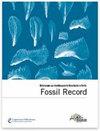德国南部晚侏罗世硬骨鱼类Tharsis的一个显著新种:形态和系统发育关系
IF 2.1
4区 地球科学
Q1 PALEONTOLOGY
引用次数: 5
摘要
摘要在保存许可的情况下,为一种新的晚侏罗世鱼类(Tharsis elleri)提供了完整的形态描述,并对德国南部索伦霍芬石灰岩中最常见的物种之一杜氏塔尔西斯的一些形态特征进行了修订和比较。本文提出了一个校正的Tharsis属的诊断——现在包括两个物种。新物种的特征是形态特征的结合,例如存在由放置在眼睛前后的两块骨头形成的完整的巩膜环,一个中等短的下颌,在眼眶的前半部分下方有方形下颌关节,尾椎骨,其各自的椎体上有神经和血道弓,和与各自的中枢融合的副教皇。对198个性状和43个分类群进行了系统发育分析。根据系统发育假说,Ascalaboidae和更先进的硬骨鱼的姐妹群关系高于Leptolepis coryphaenoides的节点。这两个节点在硬骨动物中都有强大的支持。结果证实了Ascalabos、Ebertichthys和Tharsis是这个已灭绝的家族的成员。Tharsis ellerin。sp.(LSID urn:LSID:zoobank.org:act:6434E6F5-2DDD-48CF-A2B1-827495FE46E6,日期:2018年12月13日)目前仅限于上侏罗纪德国的一个地方——艾希施塔特舍恩费尔德附近的韦格谢伊德采石场——在那里,杜氏塔尔西斯不仅在韦格谢德采石场被发现,而且在德国巴伐利亚上侏罗纪和法国塞林的不同地方也被发现。本文章由计算机程序翻译,如有差异,请以英文原文为准。
On a remarkable new species of Tharsis, a Late Jurassic teleostean fish from southern Germany: its morphology and phylogenetic relationships
Abstract. A complete morphological description, as preservation permits, is provided
for a new Late Jurassic fish species (Tharsis elleri) together with
a revision and comparison of some morphological features of Tharsis dubius, one of the most common species from the Solnhofen limestone,
southern Germany. An emended diagnosis of the genus Tharsis – now
including two species – is presented. The new species is characterized by a
combination of morphological characters, such as the presence of a complete
sclerotic ring formed by two bones placed anterior and posterior to the eye,
a moderately short lower jaw with quadrate-mandibular articulation below the
anterior half of the orbit, caudal vertebrae with neural and haemal arches
fused to their respective vertebral centrum, and parapophyses fused to their
respective centrum. A phylogenetic analysis based on 198 characters and
43 taxa is performed. Following the phylogenetic hypothesis, the sister-group
relationship Ascalaboidae plus more advanced teleosts stands above the node
of Leptolepis coryphaenoides. Both nodes have strong support among teleosts. The results
confirm the inclusion of Ascalabos, Ebertichthys and
Tharsis as members of this extinct family. Tharsis elleri
n. sp. (LSID urn:lsid:zoobank.org:act:6434E6F5-2DDD-48CF-A2B1-827495FE46E6,
date: 13 December 2018) is so far restricted to one Upper Jurassic German
locality – Wegscheid Quarry near Schernfeld, Eichstätt – whereas
Tharsis dubius is known not only from Wegscheid Quarry, but also
from different localities in the Upper Jurassic of Bavaria, Germany, and
Cerin in France.
求助全文
通过发布文献求助,成功后即可免费获取论文全文。
去求助
来源期刊

Fossil Record
PALEONTOLOGY-
CiteScore
3.60
自引率
7.10%
发文量
18
审稿时长
14 weeks
期刊介绍:
Fossil Record (FR) is the palaeontological journal of the Museum für Naturkunde Berlin. This journal was founded in 1998 under the name Mitteilungen aus dem Museum für Naturkunde Berlin, Geowissenschaftliche Reihe and appears with two issues each year. Fossil Record publishes original papers in all areas of palaeontology including the taxonomy and systematics of fossil organisms, biostratigraphy, palaeoecology, and evolution. All taxonomic groups are treated, including invertebrates, microfossils, plants, and vertebrates.
 求助内容:
求助内容: 应助结果提醒方式:
应助结果提醒方式:


